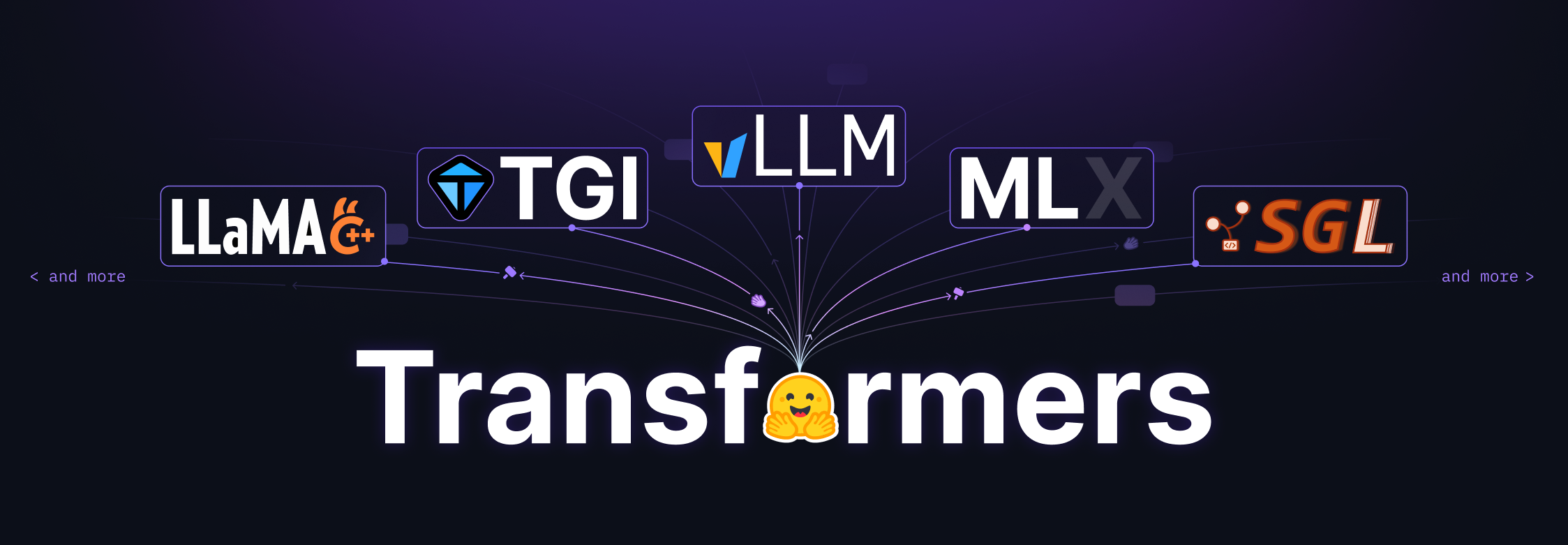SGLang 與 Transformers 後端整合
Hugging Face transformers 庫是使用最先進模型的標準工具——從試驗前沿研究到在自定義資料上進行微調。其簡單性、靈活性和龐大的模型庫使其成為快速開發的強大工具。
但是,當您準備從 Notebooks 轉向生產環境時,推理效能就變得至關重要。這時 SGLang 就派上用場了。
SGLang 專為高吞吐量、低延遲的推理而設計,現在它與 transformers 實現了無縫整合,可將其作為後端。這意味著您可以將 transformers 的靈活性與 SGLang 的原始效能結合起來。
讓我們深入瞭解此整合所實現的功能以及如何使用它。
TL;DR (太長不看)
SGLang 現在支援將 Hugging Face transformers 作為後端,讓您可以開箱即用地執行任何與 transformers 相容的模型,並實現高效能推理。
import sglang as sgl
llm = sgl.Engine("meta-llama/Llama-3.2-1B-Instruct", impl="transformers")
print(llm.generate(["The capital of France is"], {"max_new_tokens": 20})[0])
無需原生支援——SGLang 在需要時會自動回退到 Transformers,或者您可以顯式地設定 impl="transformers"。
Transformers 和 SGLang
讓我們用一個簡單的文字生成示例,使用 meta-llama/Llama-3.2-1B-Instruct 來比較這兩種方法。
Transformers
transformers 庫非常適合實驗、小規模任務和訓練,但它並未針對高併發或低延遲場景進行最佳化。
from transformers import pipeline
pipe = pipeline("text-generation", model="meta-llama/Llama-3.2-1B-Instruct")
generate_kwargs = {
"top_p": 0.95,
"top_k": 20,
"temperature": 0.8,
"max_new_tokens": 256
}
result = pipe("The future of AI is", **generate_kwargs)
print(result[0]["generated_text"])
SGLang
SGLang 採用了不同的路線,透過 RadixAttention (一種記憶體高效的注意力機制) 等特性來優先考慮效率。使用 SGLang 進行推理的速度明顯更快,資源效率更高,尤其是在高負載下。以下是在 SGLang 中使用離線引擎完成相同任務的程式碼:
import sglang as sgl
if __name__ == '__main__':
llm = sgl.Engine(model_path="meta-llama/Llama-3.2-1B-Instruct")
prompts = ["The future of AI is"]
sampling_params = {
"top_p": 0.95,
"top_k": 20,
"temperature": 0.8,
"max_new_tokens": 256
}
outputs = llm.generate(prompts, sampling_params)
print(outputs[0])
或者,您也可以啟動一個伺服器併發送請求
python3 -m sglang.launch_server \
--model-path meta-llama/Llama-3.2-1B-Instruct \
--host 0.0.0.0 \
--port 30000
response = requests.post(
"https://:30000/generate",
json={
"text": "The future of AI is",
"sampling_params": {
"top_p": 0.95,
"top_k": 20,
"temperature": 0.8,
"max_new_tokens": 256
},
},
)
print(response.json())
請注意,SGLang 還提供與 OpenAI 相容的 API,使其成為外部服務的直接替代品。
SGLang 中的 Transformers 後端
藉助新的 transformers 後端整合,SGLang 現在可以自動回退到使用其原生不支援的 transformers 模型。這在實踐中意味著:
- 可以立即訪問新增到 transformers 的新模型
- 支援來自 Hugging Face Hub 的自定義模型
- 更少的工程開銷
這在不犧牲 transformers 生態系統的簡單性和多功能性的情況下,解鎖了更快的推理和最佳化的部署 (例如啟用 RadixAttention)。
用法
llm = sgl.Engine(model_path="meta-llama/Llama-3.2-1B-Instruct", impl="transformers")
請注意,指定 impl 引數是可選的。如果模型不是 SGLang 原生支援的,它會自動切換到 transformers 實現。
任何在 Hugging Face Hub 上使用 trust_remote_code=True 且能與 transformers 正常工作並正確實現注意力機制的模型,都與 SGLang 相容。您可以在官方文件中找到具體要求。如果您的自定義模型滿足這些標準,您只需在載入時設定 trust_remote_code=True 即可。
llm = sgl.Engine(model_path="new-custom-transformers-model", impl="transformers", trust_remote_code=True)
示例
Kyutai 團隊的 Helium 模型尚未得到 SGLang 的原生支援。這正是 transformers 後端的優勢所在,它可以在無需等待原生支援的情況下實現最佳化的推理。
python3 -m sglang.launch_server \
--model-path kyutai/helium-1-preview-2b \
--impl transformers \
--host 0.0.0.0 \
--port 30000
response = requests.post(
"https://:30000/generate",
json={
"text": "The capital of France is",
"sampling_params": {
"top_p": 0.95,
"top_k": 20,
"temperature": 0.8,
"max_new_tokens": 256
},
},
)
print(response.json())
下一步計劃
我們正在積極致力於以下幾個關鍵領域以增強此整合:
效能改進:目前 transformer 模型的效能落後於原生整合。我們的主要目標是最佳化並縮小這一差距。
LoRA 支援
VLM 整合:我們還在努力增加對視覺語言模型 (VLM) 的支援,以擴大功能範圍和用例。

